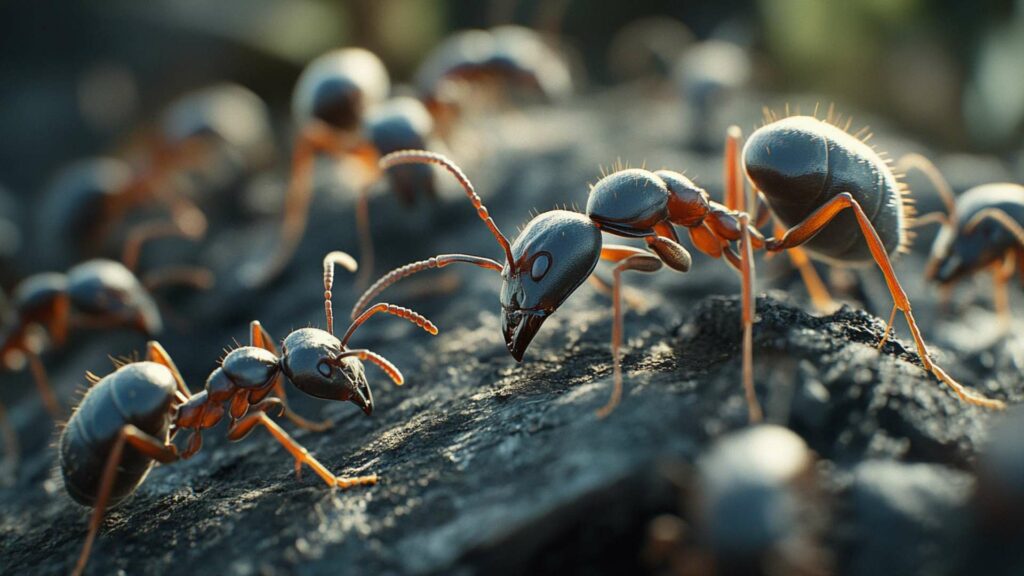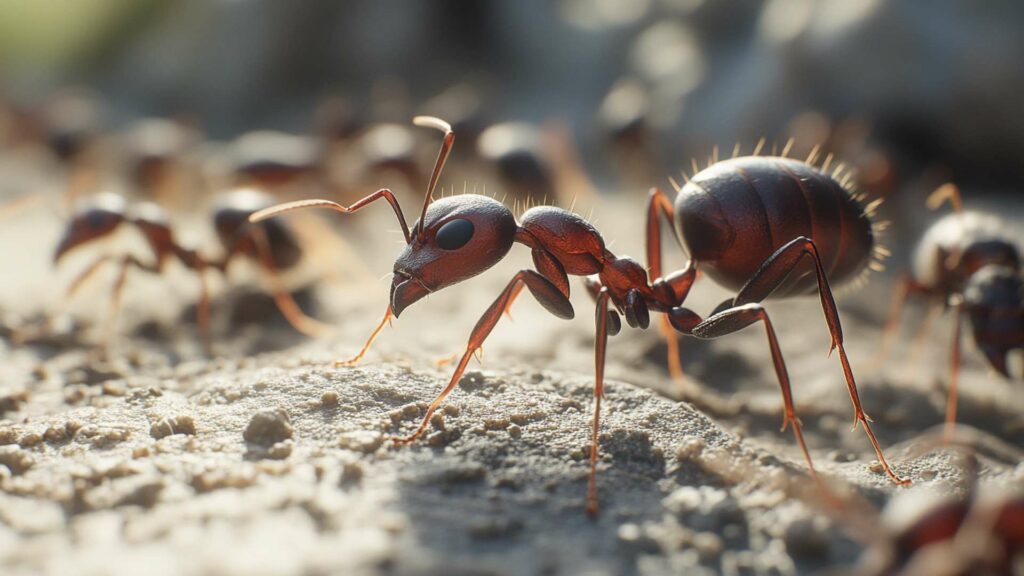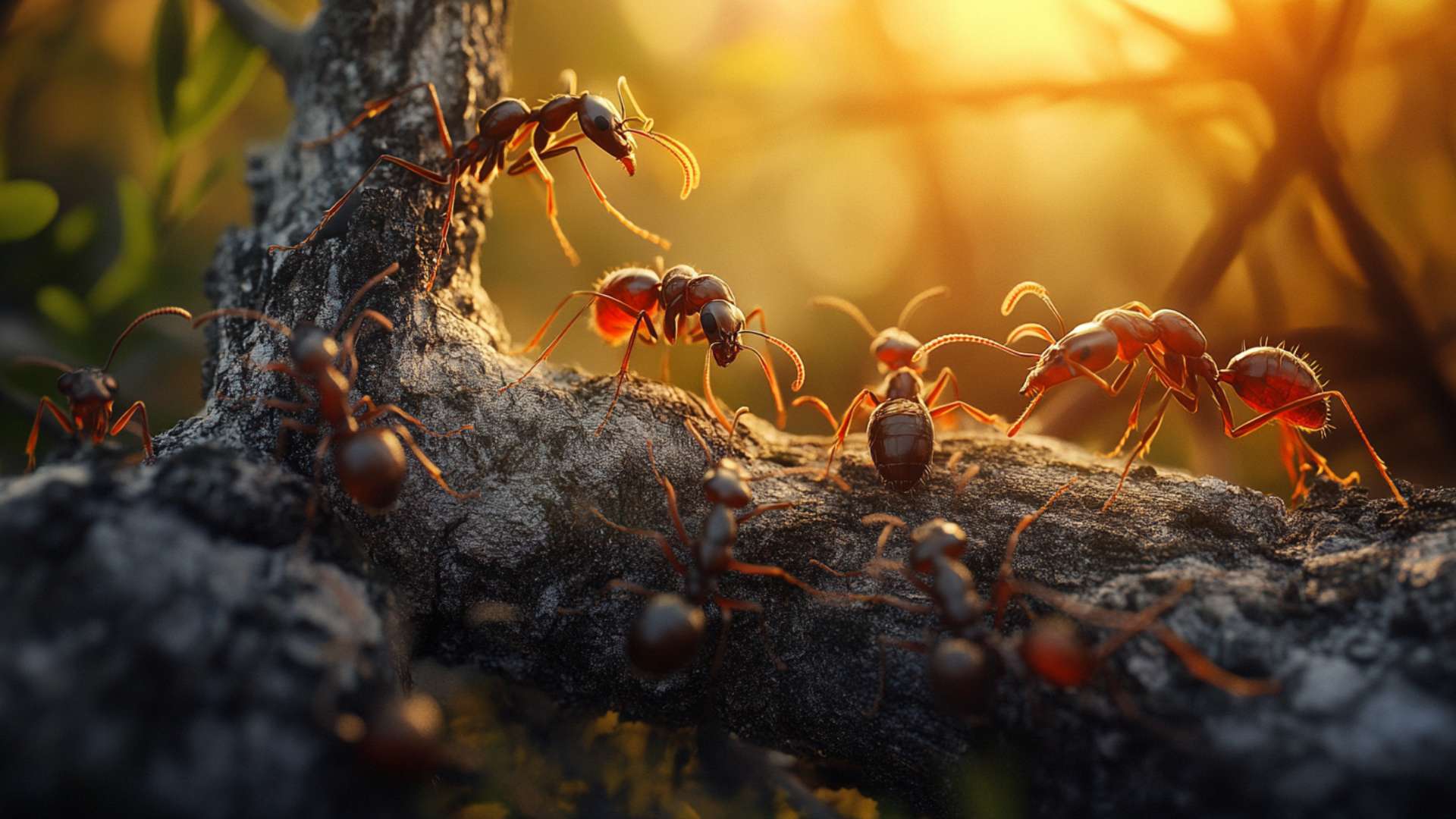Ants, those tiny creatures that scurry around tirelessly in search of food and build intricate nests, belong to the fascinating world of insects. With over 12,000 identified ant species worldwide, their diversity is astonishing.
These industrious insects have captivated the curiosity of scientists and nature enthusiasts alike for centuries. Within the body size of an ant colony, which can range from a few hundred to millions of individuals depending on body size and the species, each ant has a specific role to play.
The queen is responsible for reproduction while the workers handle various tasks such as foraging, nest maintenance, and caring for the young. The complex social structure and division of labor within an ant colony demonstrate a remarkable level of organization and animal intelligence.
A Colony with a Hive Mind?

One intriguing aspect that raises questions about ant intelligence is their ability to work collectively as if they possess a hive mind. In other words, ants seem to function as a unified entity rather than acting independently. For instance, when searching for food, ants communicate through chemical signals called pheromones – leaving scent trails that guide their fellow workers to the food source themselves.
This fascinating behavior suggests some form of intelligence at play within an ant colony. However, it also brings up an interesting question: do ants have brains?
While we typically associate brains with advanced cognitive abilities found in humans and certain animals like dolphins or primates, the investigation into ant intelligence requires us researchers to delve into what lies beneath their tiny exoskeletons. Let’s explore further and uncover the mysteries hidden within these miniature but mighty creatures.
Overview of Ant Nervous System
Ants may be small, but their nervous systems are highly organized and efficient. Just like humans and other animals, ants have a central nervous system (CNS) and a peripheral nervous system (PNS). The CNS consists of their brain and nerve cord, while the PNS includes all the nerves that connect their organs, limbs, and sensory receptors to the brain cells and CNS.
Central Nervous System (CNS)
In ants, the CNS of insect brains is relatively simple compared to larger creatures. Their brains cells are tiny clusters of nerve cells located in their heads.
These miniature brains are connected to a ventral nerve or spinal cord that runs along the length of an ant’s body. While ant brains may not match the complexity of human brains, they still perform important functions necessary for survival and colony coordination.
Peripheral Nervous System (PNS)
The PNS of ants extends throughout their entire bodies. It consists of neurons, a network of nerves that branch out from the CNS to carry signals between various body parts.
These nerves allow ants to detect stimuli from their environment using specialized sensory organs such as antennae or compound eyes. The PNS is responsible for relaying information from sensors back to the central brain for processing and response.
Brain-like Structures in Ants
Ants possess fascinating brain-like structures beyond just a centralized brain. Two noteworthy structures are ganglia and mushroom bodies.
Ganglia and Nerve Cords
Ganglia are clusters of interconnected nerve cells found throughout an ant’s body. They act as local processing units that help regulate specific functions within individual segments or appendages other insects have like legs or antennae. Along with ganglia, long, nerve cells and cords running parallel to an ant’s body enable rapid signaling between different parts.
Mushroom Bodies
Mushroom bodies, commonly found in the brains of insects, play a crucial role in learning and memory processes. These distinct structures resemble tiny mushrooms and are responsible for integrating sensory information with complex behaviors.
Mushroom bodies are involved in decision-making, navigation, and recognizing environmental cues. Researchers speculate that these structures contribute to the remarkable intelligence observed in ants.
Understanding the intricate organization of an ant’s nervous system gives us a glimpse into their amazing abilities to navigate their surroundings, communicate within their colonies, and engage in complex behaviors. Despite being small creatures, ants prove that even miniature brains can be incredibly efficient and adaptive.
Ant Intelligence: The Big Picture

Ant colonies are often considered as superorganisms due to their remarkable collective intelligence. While individual ants have small brains, the coordinated actions of a colony can achieve impressive feats.
Ant colonies exhibit a division of labor where different tasks are assigned to specific groups of worker ants, based on age and size of male ants. This efficient allocation of resources allows ants to collectively work towards the survival and prosperity of the entire colony.
Communication is the key to this division of labor within ant colonies. Through chemical signals called pheromones, ants can convey information about food sources, potential threats, or even guide each other back to the nest.
By leaving pheromone trails, ants can create an effective network that facilitates communication and cooperation among colony members. This ability to communicate and respond collectively enhances their overall intelligence.
Complex Problem-Solving Abilities
Ants are smart and not just mindless workers; they possess remarkable problem-solving abilities. For example, when foraging for food, they can navigate complex terrains while efficiently finding the shortest routes back to their nests. This smart behavior is particularly impressive given their tiny brains compared to ours.
In situations where they encounter obstacles or barriers in their path, ants demonstrate flexibility and adaptability in finding alternative solutions. They may collaborate by forming living bridges with their own bodies or employing sophisticated group strategies like tunneling through challenging terrain together.
Role of Individual Ant Brains in Colony Behavior
While individual ant brains are relatively small compared to those of humans or even other animals, they play a vital role in shaping colony behavior. Each ant brain acts as a component within a larger system that collectively makes decisions for the benefit of the whole colony.
Individual ants rely on sensory information from their environment and use it to make informed decisions about tasks such as foraging or nest-building. This visual information is processed in the ant’s brain, particularly in specialized regions like the mushroom bodies, which are associated with learning and memory.
The intelligence of ant colonies arises from the collective actions and coordination of individual ants. Through communication, division of labor, and problem-solving abilities, ants exemplify how small brains can contribute to complex behaviors and successful survival strategies.
Anatomy of an Ant Brain
When it comes to brain sizes, ants are not exactly known for their impressive cognitive capacities. In fact, their brains are incredibly small in comparison to the complex organ housed within our own skulls. To put it into perspective, while experts estimate that an average human brain consists of billions of neurons and weighs around 1.4 kilograms (approximately 3 pounds), an ant’s total brain volume is minuscule.
In fact, the brain of a worker ant can be as small as a single grain of sand! Talk about a tiny thinker!
Despite their small brains, ants have managed to become remarkably intelligent insects through other means. Instead of relying solely on the size or complexity of their individual brains, these fascinating creatures harness the power of collective intelligence within their colonies. While each ant’s brain may be limited in capacity, when they come together in a hive mind-like manner, they become capable of organizing themselves efficiently and undertaking complex tasks like finding food sources or constructing elaborate nests.
Differences in Brain Regions Between Ants and Humans
Although ants may not have impressive body sizes or large brains like humans do, they have developed unique adaptations that set them apart. One such adaptation is found within the structure of their tiny brains: the mushroom bodies. These mushroom bodies are responsible for various higher-order functions in the human brain, such as learning and memory in the ants brain.
In comparison to human brains which have intricately folded cerebral cortices enabling advanced cognitive abilities, ants lack this complexity. Instead, their mushroom bodies consist mainly of densely packed nerve cells called Kenyon cells which form structures known as calyces.
These calyces play a crucial role in processing sensory information collected by different ant body parts. While ants possess extremely small individual brains, their ability to navigate and interact with their environment is not solely dependent on the size or complexity of their small brain and cells.
Instead, they have developed specialized structures like the mushroom body calyx that allow them to process sensory information efficiently and thrive as intelligent members of their colonies. So, never underestimate the power of these tiny thinkers!
Sensory Perception in Ants’ Brains
When it comes to visual perception, ants possess remarkable adaptations that allow them to navigate their environment with precision. Their compound eyes, consisting of numerous tiny lenses called ommatidia, enable them to detect movement, colors, and patterns.
While individual ommatidia have limited resolution and function on their own, the collective input from thousands of these units grants ants a wide field of view. In addition to compound eyes, ants also have simple eyes called ocelli.
Although less sophisticated than compound eyes, ocelli play an important role in detecting light intensity and direction. Furthermore, ants have an exceptional ability to perceive polarized light—a phenomenon where light waves vibrate in a specific plane.
This unique skill aids in navigation by allowing them to determine the position of the sun even on cloudy days or within the depths of their underground nests. The combined visual capabilities provided by compound eyes, ocelli, and polarized light detection contribute to the overall sensory perception prowess of these intelligent insects.
Olfactory Perception: Antennae and Pheromone Detection
Ants and bees are renowned for their keen sense of smell which plays a crucial role in communication within ant colonies. Their antennae are equipped with specialized sensory structures that detect chemical cues from their surroundings.
By sensing pheromones released by other ants or marking trails with their own pheromones, ants can communicate vital information such as food sources or danger warnings. Moreover, workers can identify nestmates using specific odor profiles produced by the colony’s queen or specific chemicals found on the cuticles of individuals belonging to the queen ant or the same colony.
This olfactory information and communication system allows for efficient division of labor within ant colonies as workers can recognize each other’s roles based on scent. The intricate interplay between antennae and pheromone detection demonstrates the sophisticated olfactory perception that contributes to the overall intelligence of ants.
Tactile Perception: Sensory Hairs on the Body
Apart from visual and olfactory perception, ants also possess a heightened sense of touch facilitated by sensory hairs covering their bodies. These tiny hairs act as mechanoreceptors, allowing ants to detect physical contact with objects or other ants in their surroundings. This tactile perception is particularly crucial for navigating complex terrains, ensuring efficient locomotion during activities such as walking, climbing, and carrying loads.
Sensory hairs also aid ant workers in intricate movements during nest construction. Whether it’s excavating tunnels or manipulating building materials, the enhanced tactile sensitivity provided by these sensory hairs enables precise motor control and coordination among workers.
The ability to perceive and respond to tactile stimuli is an essential component of ant intelligence, contributing to their successful survival strategies within a colony. Ants’ sensory perception encompasses visual acuity through compound eyes and ocelli, olfactory acumen facilitated by antennae for pheromone detection, and tactile sensitivity enabled by sensory hairs on their bodies.
These remarkable adaptations allow ants to navigate their environment effectively while engaging in complex behaviors essential for colony survival. Their ability to perceive and process information through various senses contributes significantly to the overall intelligence exhibited by these tiny yet highly intelligent insects.
Intriguing Facts About Ant Brains

Ants can survive without their brains due to decentralized neural control
One of the most mind-boggling facts about ant brains is that they can actually survive without them! Unlike us humans, whose brains are central to our every thought and action, ants possess a decentralized neural control system. This means that even if an ant’s largest brain part is removed, it can still continue its daily tasks seamlessly.
How on earth is this possible? Well, it all comes down to the remarkable structure of an ant colony.
Each individual ant serves as a tiny worker in a highly organized society where tasks are distributed amongst various castes such as workers, soldiers, and the queen. It is believed that this decentralized neural control allows worker ants brains to rely on simple local cues and instincts rather than complex decision-making processes from a central brain.
Some species exhibit “brain-like” behavior
While ants may have tiny brains compared to human counterparts, some species display fascinating “brain-like” behavior. A remarkable example of this phenomenon is observed in certain types of carpenter ants (Camponotus spp.), where workers engage in a behavior known as “self-decapitation.” Yes, you read that right!
When these ants become infected by parasitic flies whose larvae develop inside their bodies, they instinctively chew off their heads to prevent further infection within the colony. This extraordinary self-sacrificial act showcases not only the incredible level of self-awareness but also highlights how complex decision-making processes occur even within these minuscule beings.
Conclusion
Intrigued by the question “do ants have brains,” we have delved into the captivating world of these industrious insects. While their individual brains may be tiny compared to human ones, ants possess incredible behavioral intelligence and exhibit astonishing collective intellect within their colonies.
The ability of ants to survive without their brains and the brain-like behavior seen in certain ant species further highlights the extraordinary adaptability and complexity of these remarkable creatures. So, next time you observe an ant scurrying along, take a moment to appreciate the remarkable world buzzing beneath our feet, where intelligence takes on diverse forms that we humans are only beginning to understand.
Deter Ants with D-Termination: Las Vegas’ Foremost Pest Control Solution!

Dealing with ant problems? D-Termination is here to lend a hand. Our proficient team specializes in preventing ant infestations, revitalizing cleanliness and integrity in your vicinity. Bid farewell to ants—opt for D-Termination for highly effective pest control today!
Reach out to us at 702-919-6310 or visit dtermination.com to arrange your ant control service and regain your space from these unwelcome pests.
Frequently Asked Questions:
Ants likely do not experience pain in the way humans do.
Ants do not have complex cognitive thoughts like humans.
Ants have a brain but do not have emotions in the human sense.
Ants have a brain but do not have a heart like mammals do.








